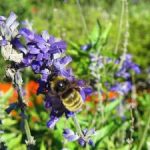Anytime there is a beautiful landscape on display, there are insects lurking in the background to take advantage of opportunities for food and shelter among the plants.
For some, insects are unwelcome visitors to the landscape and must be removed. For others, insects are a reflection of the natural order and balance in the environment and are welcome inhabitants.
Integrated pest management, or IPM, is a way to control pests by using a wide variety of approaches that don’t focus solely on pesticides, including:
- Biological control – Using beneficial insects or organisms to control pests and develop a natural pest/predator balance.
- Mechanical control – Physically removing the pest organism by hand or with traps and barriers.
- Cultural practices – Selecting plants that are insect- or disease-resistant and/or drought-tolerant.
- Monitoring – Checking your landscape periodically for the presence of unwelcome plants or insects instead of regular treatments, and watering only when the landscape needs it.
- Acceptable pest levels – Focusing on control – not eradication – and understand how many insects can be present before damage (if any) occurs to the plants.
- Responsible pesticide use – Using a pesticide only to reduce pest populations that are out of control and following labeled directions, using only recommended amounts.
With this in mind, combining a well-managed xeric landscape with IPM practices results in a beautiful array of native and drought-tolerant plants that provide color throughout the year, while maintaining a level of insect and disease resistance to satisfy even the most persnickety gardener.




